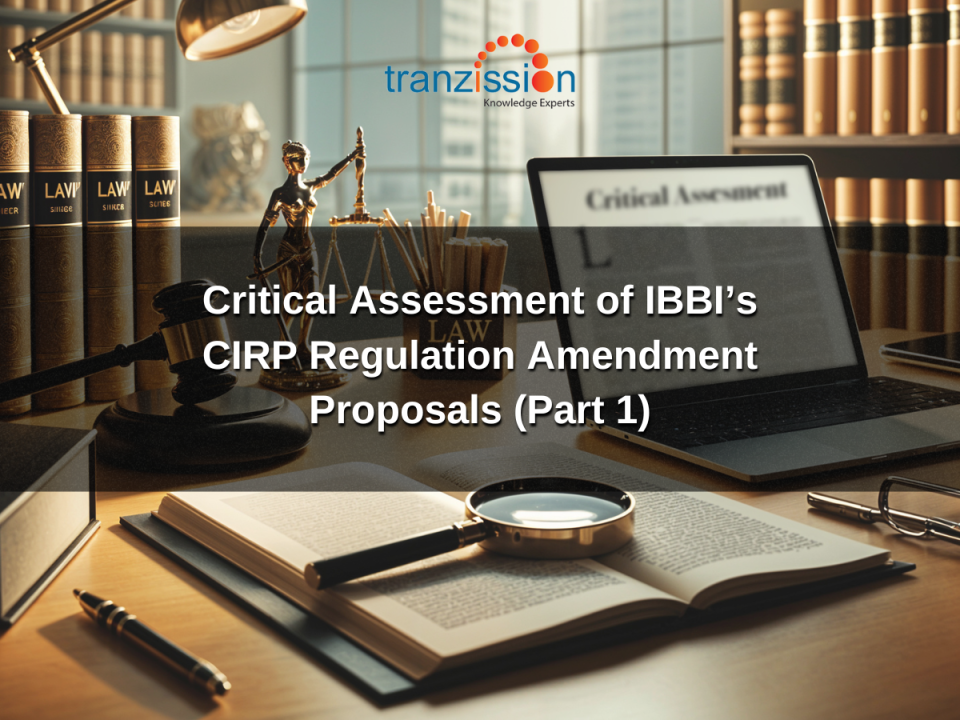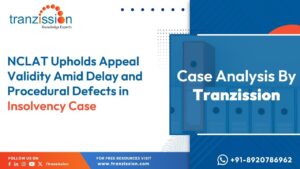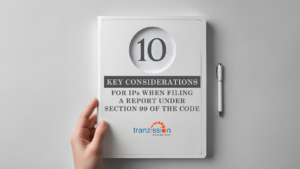
Critical Assessment of IBBI’s CIRP Regulation Amendment Proposals – Part 1

Table of Contents
Introduction
The discussion paper, issued by the Insolvency and Bankruptcy Board of India (IBBI) on June 19, 2024, seeks comments on four proposed amendments to the Insolvency and Bankruptcy Board of India (Insolvency Resolution Process for Corporate Persons) Regulations, 2016. This paper critically assesses IBBI’s first proposal to amend CIRP Regulations relating to the appointment of two valuers instead of six valuers in an attempt to align CIRP Regulations with Valuation Rules.
Proposal #1: Registered Valuer to Submit Valuation Report for the Corporate Debtor as a Whole
Current Practice: Two registered valuers (RVs) are appointed to determine the fair value and liquidation value of the Corporate Debtor (CD). If the valuations differ significantly, a third RV may be appointed.
Proposed Amendment: Align CIRP regulations with the Companies (Registered Valuers and Valuation) Rules, 2017, allowing a single RV to conduct valuations with inputs from other RVs as needed.
Rationale: This aims to streamline the valuation process, reduce inconsistencies, and lower costs by potentially limiting the number of RVs required.
Critical Assessment
a. Valuer Accepting Assignments Beyond Their Professional and Legal Competence is Legally Unsustainable
The Discussion Paper suggests reducing the number of valuers from six to two based on the premise that Valuation Rules allow a Registered Valuer to seek a separate valuation report for an asset class from another Registered Valuer. However, the interpretation that a valuer registered under one asset class can accept assignments for other classes is flawed, as outlined below:
i. A registered valuer is typically appointed based on his capability and legal authorization for a specific class of assets. Accepting an assignment for a different class than the one they are registered for exceeds their professional expertise.
ii. Rule 8(2) relates specifically to the preparation of a valuation report that a valuer is professionally qualified to handle. This rule offers the valuer two options: either perform the valuation independently while possibly seeking input from another valuer or obtain a separate valuation report for the same asset class from another registered valuer. This cannot be interpreted to allow a valuer, who lacks professional competence in a certain asset class, to accept assignments for that class. Such an interpretation is unfounded as it extends beyond the valuer’s professional capabilities. The options to “obtain inputs for the valuation report” or “get a separate valuation for an asset class from another registered valuer” are linked and pertain specifically to the class of assets for which the valuer is appointed.
iii. If the interpretation suggested in the discussion paper is correct, it would create an absurd scenario where a valuer not professionally competent to assess a class of assets could still accept such assignments. For example, if the IRP of a corporate debtor needs valuations for securities and financial assets as well as plant and machinery, it would be incorrect to allow a valuer registered for land and buildings to accept the assignment and then subcontract it to valuers registered in those specific asset classes. Such practices contradict the intent and spirit of the law.
iv. Furthermore, Rule 8(2) also requires a registered valuer to disclose in their report any inputs received from other registered valuers. The valuer remains accountable regardless of whether they perform the valuation on their own or with inputs from another valuer in the same asset class. It is unreasonable to expect a valuer to be liable for valuing an asset class outside their expertise, about which they know little, yet still bear legal responsibility. This interpretation does not align with the legislative intent.
b. No Anomaly is Present in Existing Regulation 27 Requiring Alignment with Rule 8(2) of Valuation Rules
i. Paragraphs 1.5 and 1.6 of the discussion paper address the proposal to appoint 2 valuers instead of 6, yet this change lacks a solid legal foundation. Comparing the existing Regulation 27 with the proposed revision reveals only one notable difference: under the current regulation, the Resolution Professional (RP) can appoint two registered valuers, whereas the proposal allows for the appointment of a single registered valuer for MSMEs or corporate debtors with an asset base not exceeding Rs. 1000 crores, with the option for the committee of creditors to appoint a second valuer if deemed necessary and maintains the requirement for two valuers in all other scenarios. The proposed Regulation 27 does not meaningfully align with Rule 8(2) of the Valuation Rules; its textual structure is largely unchanged, merely adjusting the criteria for the number of valuers to be appointed.
ii. Assuming the proposed Regulation 27 allows the Resolution Professional to appoint one or two valuers instead of six or three, this flexibility was already possible under the existing Regulation 27, when read in conjunction with Rule 8(2). If the existing Regulation 27 was interpreted to require the appointment of a separate valuer for each asset class, meaning six valuers, then the same interpretation should apply to the proposed Regulation 27, as there is no significant difference in the text that would suggest a change in the appointment process.
Conclusion
Based on the foregoing discussion, the proposed amendment to Regulation 27 does not adequately address the change concerning the appointment of a single valuer for the entire corporate debtor.





